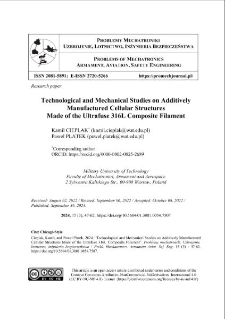Nasza Biblioteka Cyfrowa udostępnia 1 868 obiektów cyfrowych
Obiekt
Tytuł: Technological and Mechanical Studies on Additively Manufactured Cellular Structures Made of the Ultrafuse 316L Composite Filament ; Technological and Mechanical Studies on Additively Manufactured Cellular Structures Made of the Ultrafuse 316L Composite Filament
Tytuł odmienny:
Badania technologiczne oraz mechaniczne struktur komórkowych wytworzonych przyrostowo z kompozytu Ultrafuse 316L ; Badania technologiczne oraz mechaniczne struktur komórkowych wytworzonych przyrostowo z kompozytu Ultrafuse 316L
Współtwórca:
Abstrakt:
Regular cellular materials produced using additive manufacturing (AM) techniques represent a significant development trend in modern engineering materials. Depending on the applied elementary unit cell of topology, it is possible to define the course of the structure deformation process in order to obtain the highest possible energy absorption effectiveness. This feature makes regular cellular structural materials particularly attractive for a number of industrial branches. This paper presents the results of technological trials and the results of experimental studies on the mechanical properties of regular cellular structures made using 3D printing technology under compression test loading conditions. The material used for their production was the Ultrafuse 316L filament and the fused filament fabrication (FFF) technique. The proposed material is a polymer-metal composite with a manufacturing process similar to metal injection moulding (MIM). The adopted research methodology included a feasibility study aimed at achieving material homogeneity and compression tests of the developed and manufactured regular cellular structures under quasi-static loading conditions. Several structural topologies were analysed. Experimental results indicated that regular cellular structures made from 316L steel exhibit high mechanical strength and extensive plastic deformation capabilities. The utilized in this work manufacturing technology used combines the advantages of 3D printing process with the potential of powder metallurgy. The proposed technique of structure manufacturing process is much cheaper than other based on melting metallic powders.
;
Regular cellular materials produced using additive manufacturing (AM) techniques represent a significant development trend in modern engineering materials. Depending on the applied elementary unit cell of topology, it is possible to define the course of the structure deformation process in order to obtain the highest possible energy absorption effectiveness. This feature makes regular cellular structural materials particularly attractive for a number of industrial branches. This paper presents the results of technological trials and the results of experimental studies on the mechanical properties of regular cellular structures made using 3D printing technology under compression test loading conditions. The material used for their production was the Ultrafuse 316L filament and the fused filament fabrication (FFF) technique. The proposed material is a polymer-metal composite with a manufacturing process similar to metal injection moulding (MIM). The adopted research methodology included a feasibility study aimed at achieving material homogeneity and compression tests of the developed and manufactured regular cellular structures under quasi-static loading conditions. Several structural topologies were analysed. Experimental results indicated that regular cellular structures made from 316L steel exhibit high mechanical strength and extensive plastic deformation capabilities. The utilized in this work manufacturing technology used combines the advantages of 3D printing process with the potential of powder metallurgy. The proposed technique of structure manufacturing process is much cheaper than other based on melting metallic powders.
Miejsce wydania:
Warszawa
;
Warszawa
Wydawca:
Wojskowa Akademia Techniczna ; Wojskowa Akademia Techniczna
Data utworzenia:
Data złożenia:
Data akceptacji:
Data wydania:
Rozmiar:
Identyfikator:
oai:ribes-88.man.poznan.pl:2711
Sygnatura:
doi:10.5604/01.3001.0054.7507 ; doi:10.5604/01.3001.0054.7507
ISSN elektroniczny:
ISSN drukowany:
Język:
Licencja:
kliknij tutaj, żeby przejść ; kliknij tutaj, żeby przejść
Właściciel praw:
Wojskowa Akademia Techniczna ; Wojskowa Akademia Techniczna
Strona początkowa:
Strona końcowa:
Tom:
Czasopismo:
Słowa kluczowe:
mechanical engineering, additive techniques, regular cellular structures, 3D printing, 316L steel, BASF Ultrafuse 316L ; mechanical engineering, additive techniques, regular cellular structures, 3D printing, 316L steel, BASF Ultrafuse 316L
Kolekcje, do których przypisany jest obiekt:
Data ostatniej modyfikacji:
16 paź 2025
Data dodania obiektu:
16 paź 2025
Liczba wyświetleń treści obiektu:
0
Wszystkie dostępne wersje tego obiektu:
https://ribes-88.man.poznan.pl/publication/3048

